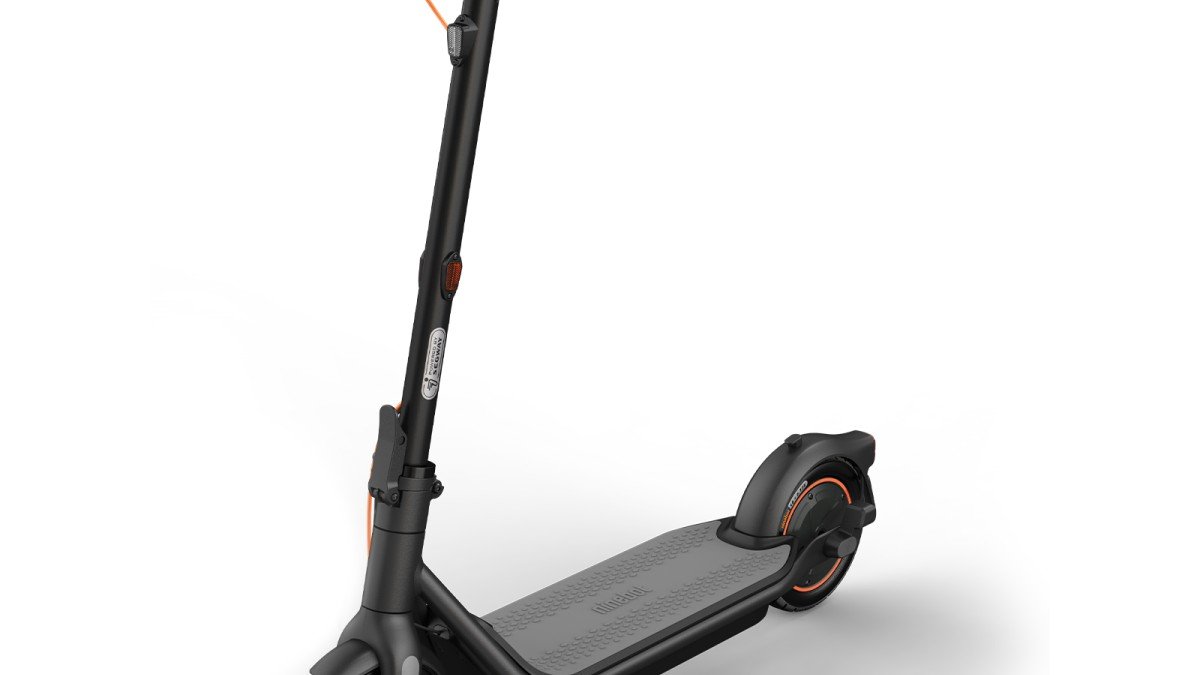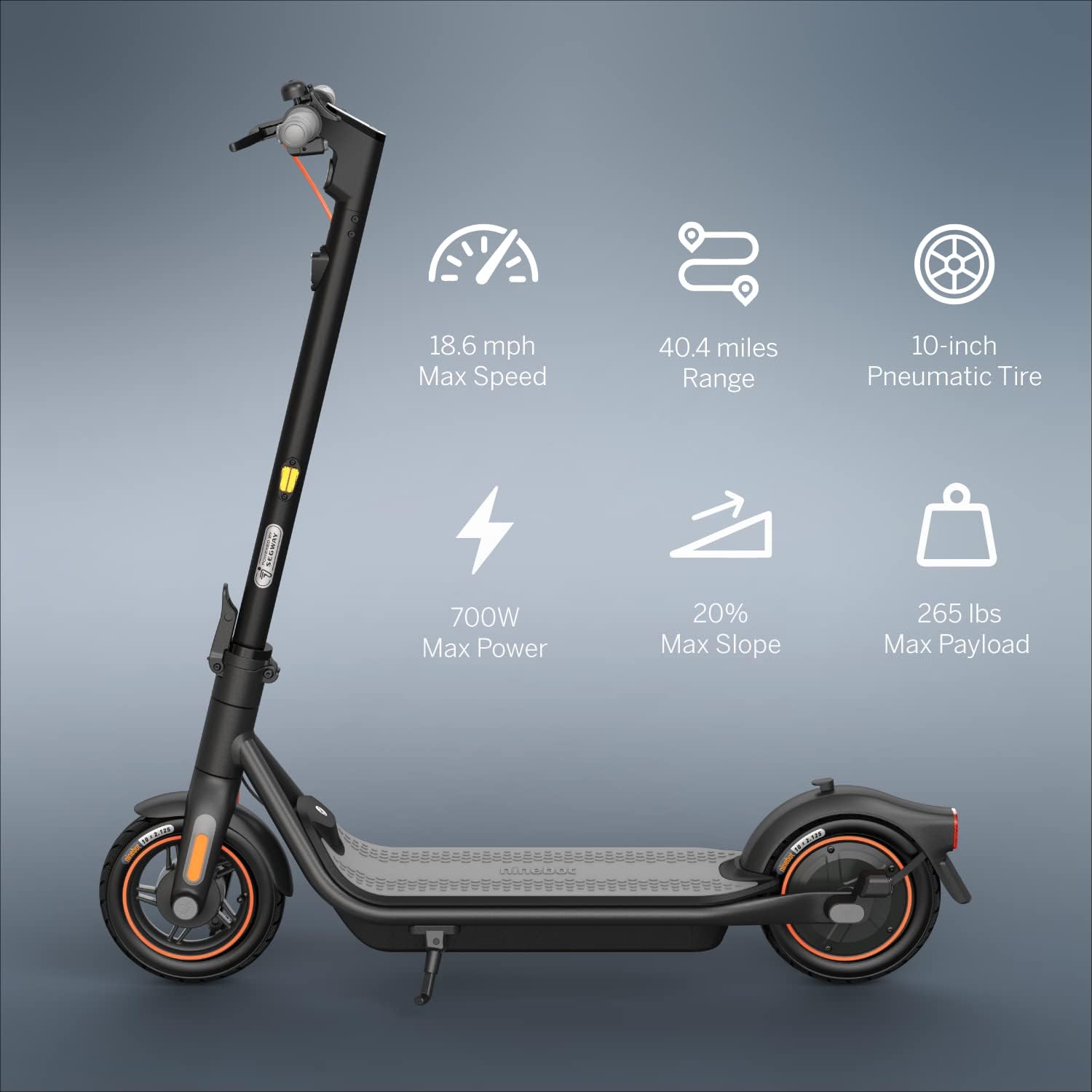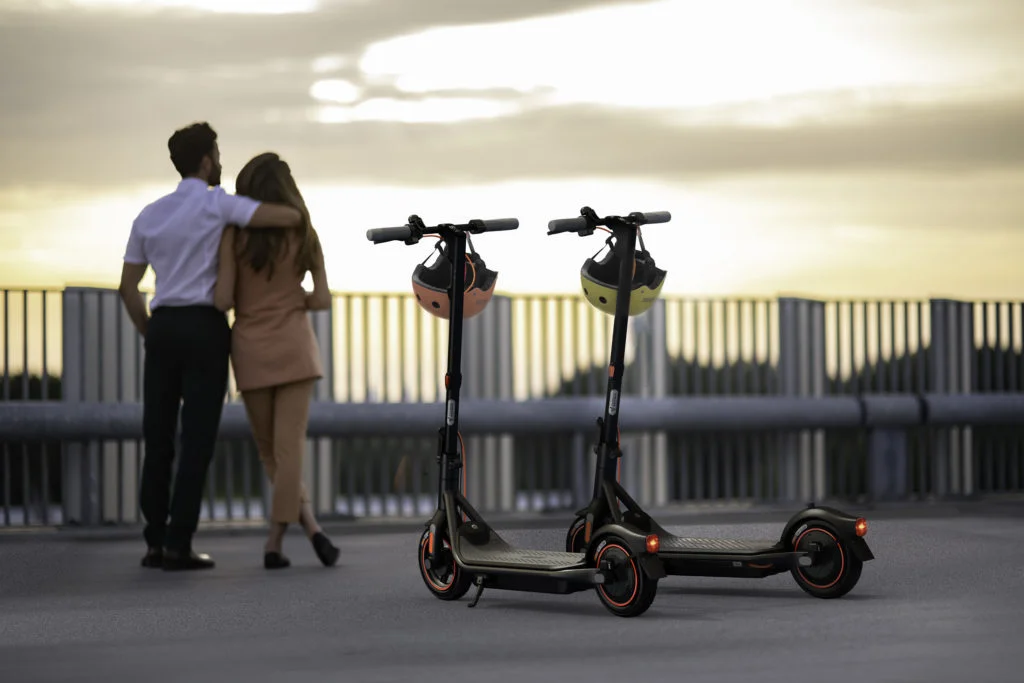
Written Review
The Segway F65 is a long-range commuter scooter that has all the features typical of Segway models. It’s named for its impressive 65 km (~40 mile) range capability, with a substantially larger battery than the older F-series models. It doesn’t have suspension, but this shaves down weight to compensate for its large battery, and the 10-inch pneumatic tires do a decent job of helping with ride comfort.
Click here for the latest price of the Segway F65.

Q: What is the max speed of the Segway F65?
A: The F65 has a top speed of 18.6 mph (which is about 30 km/h). This is the maximum speed it can reach under its Sport mode on a full battery. In Europe or other regions with e-scooter speed limits, it is capped at 25 km/h (15.5 mph) by software, but the hardware is capable of ~18.6 mph as noted in the US specs.
Q: What is the range of the Segway F65?
A: Segway advertises up to 40.4 miles of range on the F65 in ideal conditions. This assumes a lower-speed mode (Eco ~9 mph) on flat terrain. In Sport mode at full 18.6 mph, the range is more around 40–50 km (25–31 miles) on a full charge, but we would still adjust that estimate downwards. In everyday riding, we'd bet most users will see somewhere in the 20–25 mile range per charge.
Other factors that impact range are rider weight, ambient temperature (hotter is better), and overall battery health. We recommend doing a full range test in your specific conditions before trusting it as a commuter for ranges in the upper bounds of 20-25 miles.
Q: What is the battery size of the Segway F65?
A: The F65 carries a large battery – approximately 561 Wh capacity. This is roughly 15.6Ah at 46V, and is larger than the batteries in the F30 or F40 models. It is also paired with Segway’s smart BMS (battery management system) for safety (over-current, over-charge protection, etc).
Q: Does the Segway F65 have a removable battery?
A: No. The F65’s battery is built into the deck and is not intended to be removed by the user. You charge it by plugging the provided charger into the charging port on the scooter.
Q: How long does it take to charge the Segway F65?
A: Despite the large battery, the F65 advertises a relatively fast charging time of 5 hours from zero to a full charge. This is because the included charger is around 3A, instead of the 1.5A or 2A stock chargers typical of most commuter scooters.
Q: What is the weight of the Segway F65?
A: The F65 weighs 48.5 lbs (22 kg) - carrying it up stairs will be a workout. It’s a bit heavier than the Max G30 (which was ~42 lbs) and considerably heavier than the older F40 (~34 lbs). The weight contributes to stability when riding, but we wouldn't consider it to be a truly "portable" scooter.
The F65 can support riders up to 265 lbs (120 kg). This high weight capacity is in line with other Segway models and means the scooter is suitable for most adults.
Q: Is the Segway F65 single or dual motor?
A: The Segway F65 uses a single motor, located on the rear wheel with a nominal power of around 400W and peak output of about 700W.
I personally much prefer single motor scooters to have the motor in the rear rather than the front. I own a Hover-1 Journey 2.0 scooter with a front motor that I use for short commutes, and it bugs me that every time I accelerate from a stop (unless I am leaning all the way forward), the front wheel loses traction and skids for a couple feet, gradually eroding the tire tread over time.
Q: How big are the tires on the Segway F65?
A: The F65 comes with 10-inch pneumatic tires (with inner tubes). The width is standard (~2.5 inches), good for stability. Pneumatic tires provide a better ride compared to solid tires, and you’ll feel that on the F65 – it can roll over cracks and small potholes more smoothly (just make sure to maintain proper tire pressure, we recommend 35psi). Unlike the newer F3 series, the F65’s tires are not the self-healing type, so you might want to add tire sealant yourself for puncture protection, or just be extra mindful of road debris.
Q: What are the brakes on the Segway F65?
A: The F65 uses a dual-brake system consisting of a front drum brake and a rear electronic brake (regen braking). When you pull the brake lever, the front drum engages and the rear motor performs regenerative braking. The electronic brake helps slow you down smoothly and recharges the battery in the process.
Drum brakes are enclosed and low-maintenance, and they provide reliable stopping power. However, speaking from experience maintaining scooters, drum brakes are tougher to fix the rare times that they do have issues. Traditional disc brakes are easy to tune up without dismantling the wheel/hub. Not so with drum brakes.
Q: Is the Segway F65 foldable?
A: Yes. The F65 has a one-step folding mechanism. You unlock the latch at the base of the stem and the handlebar stem folds down to clip onto the rear fender, similar to other Segway/Ninebot scooters. This makes it easier to carry or store. When folded, the F65 becomes much more compact (roughly 47 inches long and 22 inches tall in folded form). Given its weight, you’ll likely use the folding primarily for storage (under a desk, in a trunk) rather than carrying long distances, but the mechanism is quick and secure.
Q: Can the Segway F65 climb hills?
A: The F65 is rated for up to a 20% incline. In practice, it handles typical city hills decently. The 400 W motor will slow on steeper hills, especially with a heavy rider, but for moderate inclines (the kind you find in many urban areas), it will make it up at 8–12 mph.
Q: Does the Segway F65 have suspension?
A: No, the F65 does not have any built-in suspension. It relies on its pneumatic tires and the flex of its frame for shock absorption. This is a common design choice to keep weight and complexity down. The 10-inch air tires do help smooth out minor bumps (much better than solid tires would).
Q: Can the Segway F65 go off-road?
A: The F65 is not intended for off-road use. It has no suspension, a relatively weak motor, and is fitted with street tires instead of knobby or off-road tires. You can ride it across a short patch of grass or packed dirt if needed – the 10" tires can handle some uneven ground – but without suspension, it’ll be a bumpy ride on anything beyond smooth terrain. Also, the motor and fender clearance aren’t meant for mud or loose terrain.
Q: Can you ride a Segway F65 in the rain?
A: Yes – the F65 has an IPX5 water-resistance rating, so riding in light to moderate rain is generally okay. The scooter has front and rear lights (the rear doubles as a brake light) for visibility, and the battery and electronics are sealed to withstand splashes.
Never charge the scooter when it has been in the rain, or when any components (including the charger itself) are wet.
Q: Does the Segway F65 have an app?
A: Yes. The F65 works with the Segway-Ninebot app (the same app as other Segway scooters). Through the app, you can monitor your ride statistics in real time, adjust settings, lock the scooter, and even enable features like “Follow Mode” (if you want to walk alongside the scooter while it powers its wheels slowly). The app is also where you set up the AirLock phone-as-key feature and pair the scooter with Apple Find My. It will also alert you of any firmware updates.
Q: What is an alternative to the Segway F65?
A: Alternatives to the F65 in the long-range commuter category include:
- NIU KQi3 Pro or Max: NIU’s KQi3 Pro offers ~31 mile range, 20 mph top speed, and the KQi3 Max goes ~40 miles, 23 mph. These have a bit more tech and sometimes dual brakes (disc + electronic). They’re strong competitors on range and build.
- Segway Ninebot Max (G30): The original Max has ~40 mile range, 18.6 mph top speed, very similar use case. It has a built-in charger like F65. If you prefer something with proven track record and similar performance, the Max is one (though it’s a bit heavier and has 10" tubeless tires).
The Freshly Charged Take
The Segway F65 is a strong contender for anyone needing a long-range commuter scooter. It's pretty straightforward – robust construction, long battery life, and decent speed. We would like to see tubeless self-healing tires, which wouldn't add too much complexity or weight, but all in all, it's a pretty good scooter.
More Segway Reviews from Freshly Charged
Looking for more Segway content? Check out our in-depth reviews across every category:
Commuter Scooters
- Segway F2 Pro Review
- Segway F3 Review
- Segway F3 Pro Review
- Segway F65 Review
- Segway D28 Review
- Segway E2 Plus Review
- Segway E2 Pro Review
- Segway Ninebot Max G30LP Review
- Segway Max G2 Review
- Segway Max G3 Review
- Segway Air T15 Review
- Segway ES2 Review
- Segway ES3 Review
- Segway ES4 Review
High-Performance Scooters
- Segway GT1 Review
- Segway GT2 Review
- Segway GT3 Review
- Segway GT3 Pro Preview
- Segway ST1 Announcement
- Segway ZT3 Pro Review
Kids & Youth Scooters
Go-Karts
Bikes
Other Vehicles

Scooter Comparison Tool
Use our Freshly Charged Scooter Comparison Tool to evaluate this scooter alongside more than 500 other scooters. Compare and organize scooters by factors such as price, top speed, battery size, weight, water-resistance rating, and more!
No comments yet…